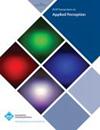虚拟环境中的嗅觉适应
IF 1.9
4区 计算机科学
Q3 COMPUTER SCIENCE, SOFTWARE ENGINEERING
引用次数: 11
摘要
视觉感知在计算机图形学中变得越来越重要。对人类视觉感知的研究导致了感知驱动的计算机图形技术的发展,在这些技术中,人类视觉系统(HVS)的知识,特别是它的弱点,在渲染和显示3D图形时被利用。关于HVS局限性的研究结果已用于保持高感知质量,但在没有感知到这种质量差异的情况下降低某些图像的计算质量。本文研究了在气味存在的情况下,这些限制可以被利用的时间(如果有的话)。结果表明,在我们的实验中,对气味的适应确实会影响参与者判断动画质量差异的能力。在进行实验之前,参与者暴露在一种气味中,他们能够以与“没有气味”条件相似的方式确定质量,而没有适应,参与者无法区分质量差异。本文章由计算机程序翻译,如有差异,请以英文原文为准。
Olfactory Adaptation in Virtual Environments
Visual perception is becoming increasingly important in computer graphics. Research on human visual perception has led to the development of perception-driven computer graphics techniques, where knowledge of the human visual system (HVS) and, in particular, its weaknesses are exploited when rendering and displaying 3D graphics. Findings on limitations of the HVS have been used to maintain high perceived quality but reduce the computed quality of some of the image without this quality difference being perceived. This article investigates the amount of time for which (if at all) such limitations could be exploited in the presence of smell. The results show that for our experiment, adaptation to smell does indeed affect participants’ ability to determine quality difference in the animations. Having been exposed to a smell before undertaking the experiment, participants were able to determine the quality in a similar fashion to the “no smell” condition, whereas without adaptation, participants were not able to distinguish the quality difference.
求助全文
通过发布文献求助,成功后即可免费获取论文全文。
去求助
来源期刊

ACM Transactions on Applied Perception
工程技术-计算机:软件工程
CiteScore
3.70
自引率
0.00%
发文量
22
审稿时长
12 months
期刊介绍:
ACM Transactions on Applied Perception (TAP) aims to strengthen the synergy between computer science and psychology/perception by publishing top quality papers that help to unify research in these fields.
The journal publishes inter-disciplinary research of significant and lasting value in any topic area that spans both Computer Science and Perceptual Psychology. All papers must incorporate both perceptual and computer science components.
 求助内容:
求助内容: 应助结果提醒方式:
应助结果提醒方式:


